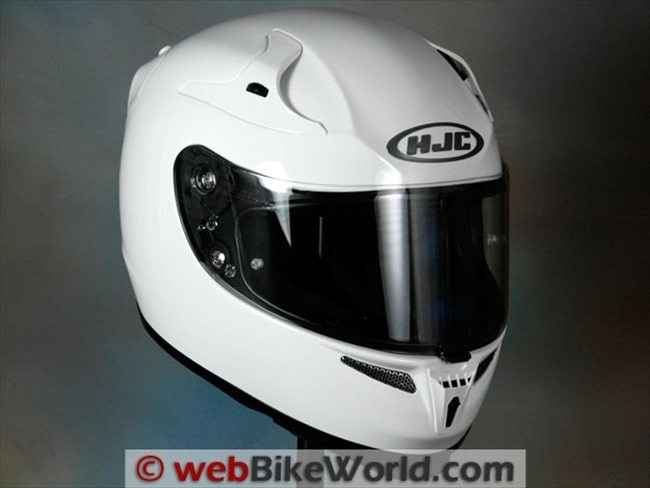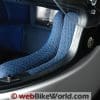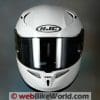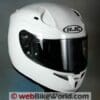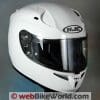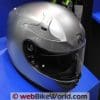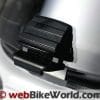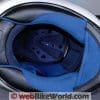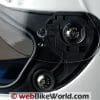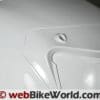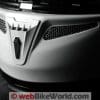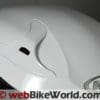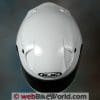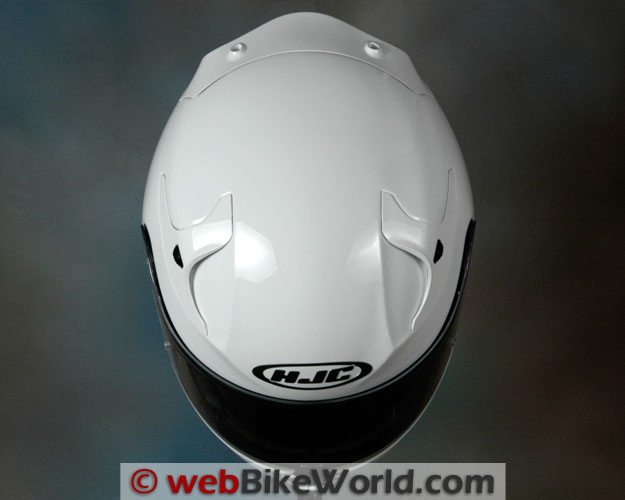The HJC RPS-10 moves slightly upmarket with a solid offering.
But how does it compare with the Shoei Qwest?
We’ve always been partial to HJC, for a number of reasons.
First of all, the helmets are available — you can find one at just about every Mom ‘n’ Pop motorcycle dealer on the planet.
That makes a big difference; after all, the “best” helmet in the world is a theory if you can’t find one to buy.
HJC also has the price/performance range completely covered.
From the bottom-of-the-line CS-series all the way up to this latest RPS-10, with stops along the way for motocross, cruising, flip-uping and even a side trip to Carbon Fiber World — if you want it, they got it.
Then there’s value.
When you can buy a helmet like the time-tested CL-series, which has been around since Odin’s skull needed protecting and get both DOT and Snell 2010 standards in a whole mess o’ colors for less than 130 bucks, we’re talking the textbook definition of “deal”.
Let’s see…what else? There’s the HJC reputation, the reliability, the support network…
Somehow, HJC seems to have it all dialed in. The only thing missing? The “Wow” factor.
The availability of the brand seems to give it less snob appeal than, say, Arai or Shark or Schuberth.
So along comes Ben Spies. And the HJC RPS-10. Is this enough to give HJC that last missing piece — desirability?
I guess the FS-series, which held top spot in the HJC lineup until the RPS-10 came along, didn’t do enough in this regard. Or HJC wanted to cash in on the Spies phenomenon. Or both. Who can blame them? It takes money to sponsor a talent like Spies!
In any case, the HJC RPS-10 is an up-market attempt by the Toyota of motorcycle helmets. Sort of like trying to sell a Lexus next to a Corolla? Hmmm…perhaps not quite.
Unfortunately, HJC’s timing was slightly off. They released the helmet just as the fantastic Shoei Qwest (review) hit the dealers’ shelves. The helmets are priced within $20.00 of each other and after wearing both for the last several weeks, I think they’re natural competitors.
It isn’t often when we have two helmets — or any product, for that matter — that are competing in the same “space” (to use an overused consulting term).
So I can’t help but compare the two and I’ll weave some of those thoughts in this review. Let’s get started…
The HJC RPS-10: Paint, Graphics and Overall Quality
Evaluating the paint and graphics on this plain white RPS-10 is even more difficult than doing the same for the metallic silver Qwest.
But it does appear that HJC did a good job on this one; the paint is very evenly applied without a hint of orange peel or dust specks.
The finish and final clearcoat feels sturdy, if anything can be told from clearcoat “feel”.
It still doesn’t have that “hard” surface commonly found on some of the European helmets (like the Nolan N90 (review) for example) and it’s difficult to determine the actual thickness of the clear coat, but overall, the finish is excellent.
Compared to the Qwest, however, there are a few immediately noticeable differences. I found a few small rough edges here and there on the RPS-10, like the edges of the plastic top and rear vent covers.
Those covers don’t quite match the curvature of the helmet, although these are very small nits to pick. This RPS-10 also has a couple of stitching miscues and a loose thread here or there, which also reinforces the differences.
But it’s these very little things that make the difference when comparing the two helmets, although I’ll still give an “Outstanding” rating to the RPS-10.
Compared to other HJC helmets, the RPS-10 is definitely a step up and I do think the helmet is probably the equal of some of the best quality helmets available. Is it that much of a step up, however, from the HJC FS-15 (review)?
Ummm….I’m not so sure about that.
The biggest noticeable difference between the Qwest and the RPS-10 becomes apparent on the inside of the helmet. I just don’t think that the RPS-10 is as comfortable as the Qwest.
The liner fabric used in the HJC is smoother but not as plush as the fabric used in the Qwest, and the padding doesn’t feel as thick either.
The fabric does seem to dissipate heat better in the RPS-10 than the Qwest however, which keeps my head cooler.
But the smooth material seems to pull or pill very quickly; my beard stubble created some pilling in the fabric on the edges of the cheek pads the very first time I wore the helmet, which doesn’t bode well for longevity.
The bottom line here is that I just think the Qwest interior is a more comfortable place to spend some time, so I’d rate the RPS-10 as a “Very Good”, which is two notches down from the Qwest’s “Outstanding”.
Again, it’s unfortunate for HJC that both helmets arrived in one box. It’s possible that I would be singing a different tune if the RPS-10 arrived first, without a Qwest for comparison…but I don’t think so.
After reviewing around 150 motorcycle helmets over the last 10 years, I have a pretty good database of knowledge built up in those little gray cells, which does help at comparison time.
The other bits and pieces on the RPS-10 all work very nicely and the liner is carefully installed. It’s also fully removable, unlike the Qwest, which has removable cheek pads only.
Score: I’ll give the HJC RPS-10 an “Excellent” rating for paint (in solid colors) and overall fit and finish. See the Summary Table at the end of this page for a description of our rating system.
HHJC RPS-10 Helmet Fit, Internal Shape and Liner
Other differences between the RPS-10 and the Shoei Qwest are apparent in the fit and the internals.
I’ve been wearing both helmets back-to-back on rides and I have them right next to me here in the office as I’m writing this, so I can say with confidence that the Qwest is a neutral to slightly round shape, compared to a neutral to slight narrow fit for the RPS-10.
In fact, the RPS-10 probably shades closer to slightly narrow than the Qwest does to slightly round. I think the internal shape of the RPS-10 is felt in a more immediate way because the helmet shell overall feels a bit more snug than the Shoei.
The Qwest comes in a remarkable 5 different shell sizes, but HJC doesn’t list the shell sizes for the RPS-10, at least that I can find.
Since the RPS-10 is available in sizes ranging from XS to XXL (XXS to XXL for the Qwest), my guess is there are perhaps two shell sizes, one to cover XS, S, M and one for L, XL, XXL?
The internal fit of the size large RPS-10shown here feels slightly small, about 1/2 size smaller than expected and not as roomy as the size L Shoei Qwest.
Where the Qwest feels all cushy and soft and padded inside — and fits my very round head nearly perfectly, the RPS-10 feels like it has thinner padding, which again makes the difference in the internal shape more apparent.
I can definitely feel the oval-ish form towards the top of the RPS10; there’s slightly more room at my forehead and the cheeks feel tighter.
Also, my chin hangs out the bottom of the helmet, although the large chin curtain masks this to a certain extent. The RPS-10 feels like it’s sitting a bit high, so all of this combined tells me that the helmet has a slightly narrow shape.
It fits but in reality it is probably not the best choice for my particular head shape.
Since internal shape and fit is based personal preference, this isn’t something I’m factoring into my ratings, however. The biggest difference though is in the padding, which feels thinner in the RPS-10 and the liner material, which just doesn’t feel as plush or soft to me.
Also, the padding under the chin strap in the RPS-10 is not long enough to cover my neck, so the unprotected central part of the strap causes quite a bit of chafing on my skin.

Taking everything into consideration, I’ll have to shade my final shape rating on the RPS-10 also, making it a split between “Neutral” and “Slight Narrow” in the chart above.
Ultimately, I’ll call it a “Neutral” though because I do think it should fit a wide range of head shapes.
The RPS-10 has relatively deep ear pockets, which should be adequate for speaker mounting.
The pockets have a thin section of padding at the bottom but it looks like speakers could either be mounted on top of the material, underneath against the EPS liner or it may be possible to cut out the liner at the pockets and mount the speakers directly on the EPS.
More information on helmet fit can be found in the webBikeWorld Motorcycle Helmet FAQ page, along with the chart that lists the helmet weights of webBikeWorld reviewed helmets and also by shape on the webBikeWorld Motorcycle Helmet Shapes page.
Score: I’ll give the HJC RPS-10 an “Excellent” rating for an internal shape that should fit a wide majority of head shapes, a comfortable liner that isn’t as comfortable as the Shoei Qwest, with slightly thinner padding and slightly lower quality of material.
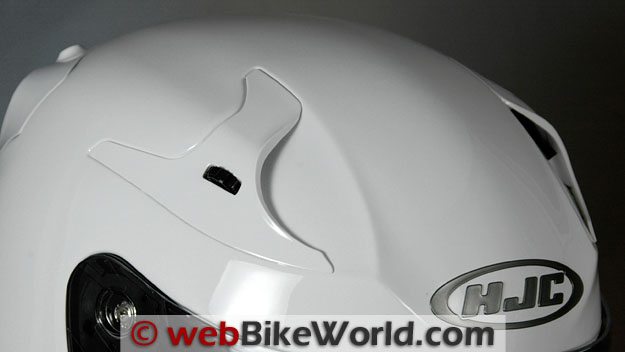
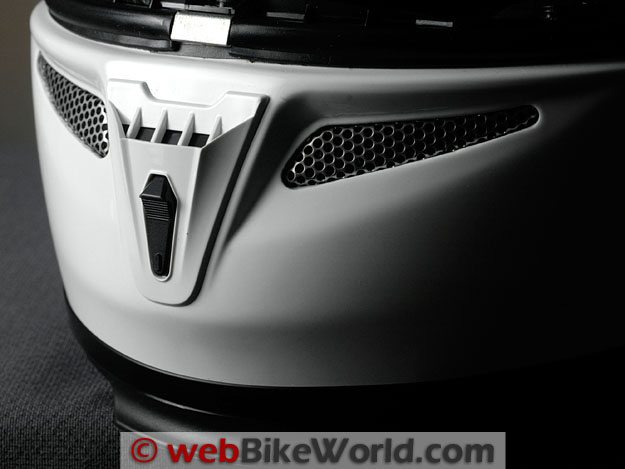
HJC RPS-10 Face Shield, Eye Port and Visibility
Another new helmet, another new face shield and ventilation system… I guess the manufacturers must figure that since it’s much easier to recognize that something new and pry shekels out of a customer’s pocket if a helmet has a redesigned face shield and vents.
After all, a new helmet shell material is completely invisible to the prospective buyer.
So now we have another type of face shield lift system. The RPS-10 has a type of spring clip lift tab on the center of the face shield.
The central mounting position is a plus, because it can be grabbed with either hand and this location helps prevent twisting or torque of the face shield when it’s lifted.
But having to squeeze the spring-loaded tab together to both lift and close the face shield makes it one step too fussy, in my opinion. I gave it time, thinking I’d get used to it, but I haven’t yet.
It takes a positive action and you sort of have to think about what you’re doing, especially when closing the shield (see the video below) which takes concentration for a task that should be a very simple operation. So I’m not a fan of the new HJC lift tab system.
On the plus side, the new tab system does serve to lock the face shield closed and it does have a slight first opening to allow defogging.
But so does the Shoei system, in a simpler fashion I think (although that one still isn’t perfect yet either). I’d rather see a hybrid of the Arai system, which uses a click arrangement to lock the face shield, but perhaps located in the lower center position on the shield.
Note that apparently the Ben Spies replica will have a “normal” face shield without this lift tab; see the note from D.M.B. in the Comments section below.
So this may be an option for owners who wish to replace the new face shield design with a traditional version.
The HJ-20 face shield is marked as meeting VESC-8 specs and it has good optical qualities. It is slightly chamfered inwards at the top and bottom on the outside, just like the face shield on the Shoei Qwest.
However, there is some distortion at the lower edge, around the centrally located lift tab mechanism.
The RPS-10 face shield seals tightly against the 360-degree eye port gasket and it does pass our water resistance test. The excess water is shunted behind the face shield and out on to the sides of the helmet, rather than into the eye port itself.
The RPS-10 does not have the same outstanding outward visibility of the Shoei Qwest however.
This is one of those things that, were it not for the Qwest, the comparison wouldn’t be as dramatic. But the RPS-10 chin bar seems taller than the Qwest, so the vertical sight lines aren’t as generous.
I removed the breath guard almost immediately from the helmet because it blocked too much of the eye port.
The horizontal visibility is good, probably slightly better than average. We’ve been working on a way to quantify the eye port visibility in terms of included angles of vision and hope to report on that soon.
So in the meantime, it’s a subjective rating.
The face shield measures 2.1 mm thick on this helmet. It is fitted with Pinlock pins and a Pinlock anti-fog insert (review) is included in the box, although ours was bent due to a packing error, which made it unusable.
The face shield uses the HJC “RapidFire” removal system, which works well and is illustrated in the video below. The base plate has two stainless steel Philips head screws on either side for adjustment, if necessary, but our face shield fits tightly, so no problem there.

Score: I’ll give the HJC RPS-10 a “Very Good” rating for the overall quality and operation of the face shield and eye port. This compares to an “Outstanding” given to the Qwest.
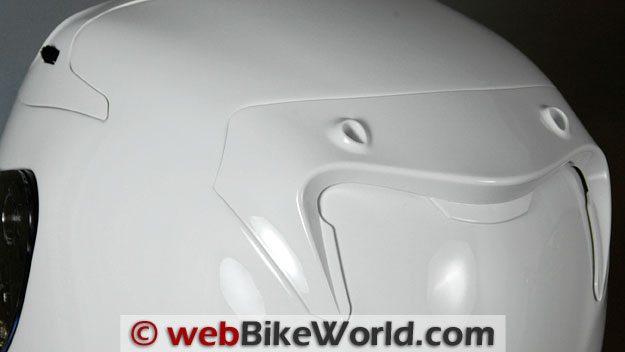
Ventilation and Air Flow
The ventilation on both the Qwest and the RPS-10 isn’t perfect, but it could be, if only the Qwest had the top vents of the RPS-10 and the RPS-10 had the chin vent of the Qwest.
HJC invented yet another new top venting system for the RPS-10. This one uses a click roller wheel to open and close the vent covers. The wheel has 5 detents, which honestly is 4 too many.
All you really need is “Open” and “Close” and you’d be all set. To have two independently operating top vents, each with a roller wheel with 5 clicks, is overkill.
Fortunately, the top vents on the RPS-10 work rather well, and I think a lot of the credit goes to the always-open rear exhaust diffuser, which seems to pull air through the helmet.
The large scoops on either side of the top of the helmet direct a good amount of air through the vents (when they are opened to level 5).
The air is directed down through two vent holes above the brow, both of which are open directly on to the rider’s head and located in channels molded into the EPS.
Strangely, the vent holes are canted forward, instead of back towards the rider’s head, but the system still works.
The exhaust vent holes at the other end of the molded channels are canted at the correct angle and the holes are larger than the intake holes.
So air is forced down into the helmet through a pair of holes in the front and runs unimpeded in channels along the top of the head and out the back. This provides what I think is better than average top ventilation.
The chin vent is a different story. Looking at the design, it should provide excellent air flow, in theory. The chin bar has large horizontal vents cut through, located towards the top of the inside.
But this is packed with some type of thick heavy mesh, which effectively blocks most of the air that might come through.
The chin vent opening itself is rather small, especially considering the fussy design of the assembly tacked on to the front of the chin bar. The air must go over the top of the vertical vent to enter the hole.
Designers, here’s a tip: when you make a vent, point the opening towards the direction of air flow. Makes sense, right?
The helmet has a large chin curtain installed, so any air coming in through the chin vent should be felt. But the chin venting system on the RPS-10 is very weak, and it gets hot in there, especially at low speeds.
Before I forget, the EPS used in the RPS-10 is also treated with some type of coating or paint on the inside, just like the Qwest. So this is a plus.
Bottom line here is that despite HJC’s claims of many hours of work on the venting system, I believe the styling of the chin vent got in the way of what could be an effective system. The irony is that this exactly swaps my scoring compared to the Qwest.

Score: I’ll split the difference here, giving the RPS-10 an “Outstanding” rating for upper ventilation but “Poor” for the chin vent. I suppose that averages out to a “Neutral”.
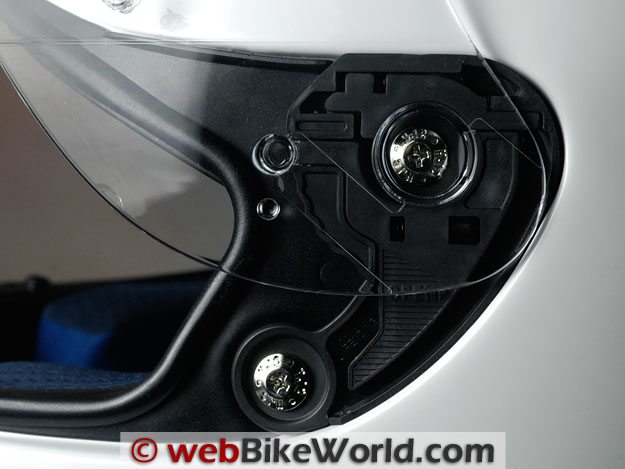
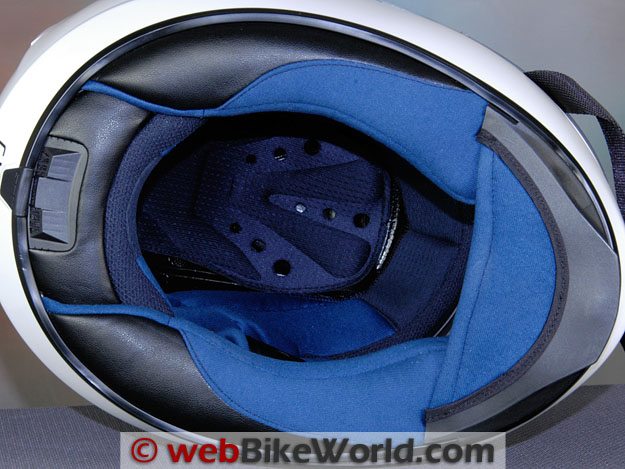
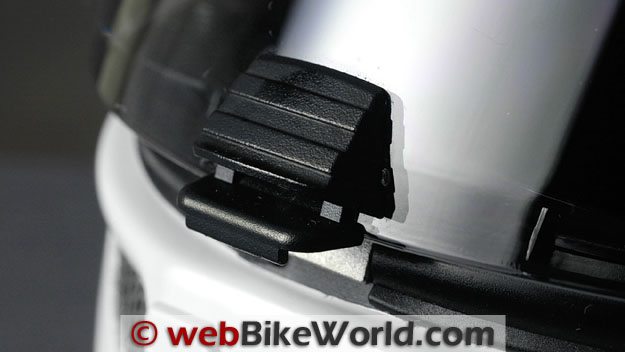
HJC RPS-10 Sound Level
Both helmets are fairly equal when it comes to noise control. The top vents of the RPS-10 coincidentally produce the same type of lower-level “tearing paper” noise I noticed in the Qwest.
Actually, considering the rather large dual scoops on the RPS-10, which by all rights should produce a loud volume of noise, the results aren’t bad.
Noise through the chin vent on the RPS-10 is subdued and the helmet design also seems to control noise around the bottom, except for that too-common problem of noise that seeps in from the split at the rear of the cheek pads where they meet the helmet liner.
I can place a thumb in the slot and the noise levels drop dramatically.
But overall, my feeling is that the RPS-10 is about equal with the Qwest, which is good. I’ll give it the benefit of the doubt with a “Quiet” rating, even though it’s probably closer to what I consider average, so I’ll use the shaded indicators in the chart below.

Note that our helmet evaluations are a combined effort of several riders over time on different types of motorcycles with and without windscreens.
Evaluators wear correctly fitted, high quality ear plugs (even when evaluating motorcycle intercom systems).
Always protect your hearing when riding a motorcycle. See the wBW Earplug Reviews for more information on choosing and wearing earplugs.
Note also that perceived noise levels will vary, depending on the individual.
Noise can be caused by many factors, including helmet fit, the type of motorcycle and windscreen, wind speed and direction and even the rider’s clothing.
For more information on helmet noise, visit the wBW Motorcycle Helmet Noise page.
Score: I’ll give the HJC RPS-10 a “Very Good” overall rating for noise control.
Helmet Weight
The RPS-10 is one of the lightest helmets available that meets both DOT and Snell 2010 safety standards; in fact, it may very well be the lightest non-carbon-fiber helmet meeting the standards.
HJC’s own FS-15 Carbon (review) at 1514 grams and the now-discontinued AC-12 Carbon (review)(1489 grams), both in size XL, are lighter — but only by a few grams.
All of these weights are recorded on the webBikeWorld Motorcycle Helmet Weights page.
The RPS-10 in size large shown here weighs 1525 grams (3 lbs., 5-3/4 oz.), an excellent showing that currently places it at number 25 out of 150 helmets weighed.
Other helmets in this neighborhood include the AGV Stealth (review) at 1536 grams and the AGV K3 (review) at 1543 grams, both in size XL but neither meeting Snell 2010.
This compares to the Shoei Qwest (review) weight (size large) of 1648 grams, which is 123 grams (4.3 oz.) heavier.
The RPS-10 helmet shell is made from a type of composite fiberglass; HJC calls it their “Advanced Premium Integrated Matrix”.
It consists of “aerospace grade aramid combined with pre-impregnated (!) fiberglass twill and layers of strong organic fabric”, according to the company.
The RPS-10 feels relatively light, although I was surprised when I looked at the scale, thinking it might be heavier. Other than the slightly peculiar fit for my very round head mentioned above, the helmet feels well balanced and I haven’t noticed any undue buffeting or lift.
As far as I can tell, HJC hasn’t reported on the shell size range for the RPS-10, so it’s not clear how the shell sizes are distributed across the head size range.
All of these weights are available on the wBW Motorcycle Helmet Weights page, along with a chart that lists the helmets by weight and shape on the wBW Motorcycle Helmet Shapes page.
Score: I’ll give the HJC RPS-10 an “Outstanding” rating for relatively low weight compared to other helmets.
Miscellaneous
The RPS-10 meets both DOT and Snell 2010 standards when sold in the U.S. The helmet is sold as the HJC R-PHA10 in Europe, where it meets ECE safety standards of course.
The RPS-10 has a five-year warranty, and it’s interesting to note that HJC doesn’t promote this fact very loudly; it’s buried on the last page of the owner’s manual, in small print.
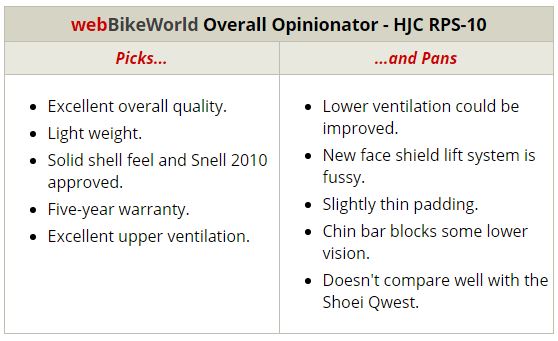
Conclusion
The RPS-10 moves HJC upmarket slightly, although my feeling is that the helmet isn’t that much of an improvement over the FS-15, which I actually prefer — and which lists for $219.99, some $129 less than the RPS-10.
129 bucks is a lot of money in my book — enough for a nice pair of gloves or boots.
I’m not sure the RPS-10 offers that much of an advantage over the FS-15 to spend the extra money.
The RPS-10 is an excellent helmet, no doubt about it, especially for those with slightly narrower heads that might not fit correctly in the rounder shaped Shoei Qwest.
But I also feel that the overall quality, fit, finish and especially the liner and padding in the Qwest is superior to the RPS-10, and well worth the $20.00 extra cost (solid colors).
| wBW Review: HJC RPS-10 (HJC R-PHA10) Helmet | |
|---|---|
| Manufacturer: HJC Helmets | List Price: $349.99-$499.99 |
| Colors: Varied | Made In: Korea |
| Sizes: XS-2XL Shell Sizes: Unknown | Review Date: October 2010 |
|
Rating Scale is subjective: Unacceptable, Poor, Neutral, Very Good, Excellent, Outstanding.
|
|
Note: Item provided by a retailer, distributor or manufacturer with these Terms and Conditions.
Owner Comments and Feedback
See details on submitting comments.
Update from “J” (See Below) (July 2011): “I’m the guy who had the failed chin strap on the HJC RPS-10 a couple of months ago (see below). All is well, very happy with the helmet. I ride frequently late at night and the bugs can be quite bad.
As you know, the RPS-10 is equipped with a Pinlock insert, but what’s really interesting is that the HJ-20 visor is ready to accept tear-off posts. I have plenty of old tear-offs left over from my racing days which will fit this visor.
A perfect solution to the late night bug problem, right? Wrong.
Incredibly, HJC includes a single tear-off post with the RPS-10. What good is that? They might as well sell me a half pair of pants.
My local dealer and I have checked other new boxes and found only one tear-off post included, so I wasn’t shorted, this is how they all ship. Where is the logic? They ought to include two tear-off posts, or none at all.
My local dealer is unable to help as a part number or a listing doesn’t exist. E-mails sent to the Canadian distributor have been ignored. I have e-mailed HJC America Inc. to no avail.
After initially pointing the finger at Pinlock, HJC finally admitted they manufacture the part themselves, but then said the item is not available. The tone of their e-mails also suggests they’re simply not interested.
Surely HJC can do better than this. I’m not asking for a freebie, rather I’d like to purchase one simple tear-off post. Why does it have to be this difficult? It’s too bad HJC is uninterested in providing some service.
I don’t believe I’m being a difficult customer. I know where I’ll be spending my money next time.”
From “K.F.” (July 2011): “I liked the review and the comments, but thought I would add a couple about the center latch.
While the center latch might obstruct your view if you had the shield at a true half way open position, I never actually ride with it there.
I often ride with it just unclipped, or one click up, and in both cases it�s far enough into your peripheral vision that you don�t notice it.
You can still see what�s on the other side of it with one eye, and your brain fills in for the other–much like you don�t notice the A-pillars on most cars unless they�re wide enough to block a significant angle from both eyes simultaneously.
The other disagreement with the center latch is that you have to squeeze it to raise the shield. I simply place my thumb under it and push up, unlatching it and lifting the shield in one continuous motion, not unlike the typical �left side handle� except that I can use either hand.
Being able to use either hand seems trivial, but I find that I use my right fairly often when coasting up to a traffic light, with my left hand holding the clutch.”
Rick’s Reply: I agree with the advantages of placing the lift tab in a central location, which is almost always better than having the tab on the left side.
However, the latch is designed to keep the face shield closed and locked at speed and leaving it unclipped sort of defeats the purpose. If the shield isn’t locked shut, it can lift unexpectedly when riding, not a good situation.
From “J” (June 2011): “Thanks for your review of the new HJC RPS-10. My thoughts are similar: light weight, great upper ventilation, quiet, comfortable.
The helmet fits my noggin nicely, with no pressure points after an hour or so. A little difficult to remove, but I’m learning to live with it; pushing the chin guard above the chin prior to removing the lid is helpful.
Lower ventilation is poor, but no big deal for me. I like the face shield lock, simple to operate with either hand and does not interfere with vision when open.
The Pinlock is easy to install, effective, and has no detrimental effect on vision.
Here’s where it all went bad: On my second day of riding with this lid, I put it on, threaded the strap through the D rings, gave it a light pull, and the entire strap fell apart. Quite shocking.
Upon inspection, it was clear that the stitching on the left side strap which holds the D rings had failed completely; it was simply gone. So, I was left with the D rings now hanging on the right side strap, and no way to fasten the helmet.
I was not at home and with no other helmet available, I was left with no choice but to hastily tape the left side strap together, then fasten the helmet in the normal fashion. Not an ideal solution, especially if the worst had happened.
I’ve ridden for a number of years, have owned numerous helmets, and have never seen a failure as shocking as this. I really like the RPS-10, it’s my first HJC, so am willing to accept this as a one in million happening, and have had my dealer order another one.
They have, in the meantime, loaned me an IS-16, which is nowhere near as nice as the RPS-10, but that’s another story.
Please warn other RPS-10 (and perhaps all HJC owners) users to thoroughly inspect their straps and stitching.
Follow-up #1 From “J”: “I have given the helmet back to the dealer, but now regret not taking some photographs.
The dealer will contact the distributor (Parts Canada) on Tuesday, or so they say. When first approached, the fellow at the counter shrugged and said it will have to wait until the distributor can comment on Tuesday (today is a holiday here in Ontario).
Not good enough, I said, I just spent a lot of money on a new bike and helmet and now I can’t ride.
A more sympathetic and somewhat embarrassed fellow took over, looked for a replacement, but no stock. He ordered one and got me the new loaner. Of course, they said they’ve never anything like this before.
I agree this is most unusual, and cannot account for it. The helmet was brand new, in the box with all tags, documentation, etc. It was not a display model on the shelf.
It doesn’t appear to have been tampered with, but I never looked at the strap closely. A quick glance was all it got.
Very curious, earlier that afternoon when leaving the office, I put the helmet on and something just didn’t feel right. I thought I had somehow twisted the strap, so I undid it, then refastened it and all was well. I guess this was the beginning of the stitching coming apart.
I’ll let you know as I learn more.”
Follow-up #2 From “J”: “All’s well that ends well. I received the replacement RPS-10 tonight. Everything looks good, though I haven’t had the chance to ride yet.
Very happy to be back in the RPS-10 after riding a couple of weeks with the IS-16, definitely not a helmet I would want to own.
The new helmet had the tags, users manual, and spare visor assembly screws in a plastic bag attached to the strap with one of those little plastic stringy things used to affix tags to clothing. I think you’ll know what I mean.
This package was not attached to the original helmet, rather it was found in the box. The only thing I can think of is someone carelessly cut the tags off, but you’d have to be a butcher to do the kind of damage I saw.
On further thought, a more likely reason is that the sewing machine ran out of thread. I’m no expert, but I understand that sewing machines operate with upper and lower spools of thread which interlock with each other.
If one spool runs out, the other stitches have nothing to hold on to. Surely, though, modern equipment would have save guards against this?
In any case, I’m glad to have a new lid. I hope this nothing more than an anomaly.”
From “M.G.” (May 2011): “I’ve been riding with one of these for almost 8 months now and have to say the venting in outstanding.
From a safety point it has a dual layer EPS. I have had no issues center lock shield system with one hand either. The system does seem to get easier with time as well.
My connections a HJC tell me they use 3 shells for every 2 sizes so XS-S = 1 shell; M-L = 1 shell; XL-XXL = 1 shell.”
From “S” (April 2011): “I enjoyed reading your review of both helmets and I believe that I have a good understanding of the minor differences. I believe that, after reading your reviews either helmet would be an excellent choice to protect my grey matter.
However, I slightly disagree with your comments in the fit of each helmet.
Perhaps my head is not the same shape as yours but I found the RPS-10 to be much more comfortable to wear and easier to get on and off. I have a damaged left arm and must use only my right to install and remove a helmet, the HJC works better for me here.
My reason for wearing a full face helmet is for cold and inclement weather only while on an extended trip. Mostly I wear a half helmet for cruising close to home and on hot days.
I also have a HJC FS-3 which is a beautiful helmet and fits like a glove.
I guess that if a helmet meets the safety standards a rider wants the rest is pretty much a personal choice. For me I like the Snell rating and the fit which has led me to choose HJC for my head. Thank you for your reviews. Very informative.”
From “J.P.B.” (March 2011): “I’ve been out of motorcycling for a number of years, so when I got back into it you can imagine my surprise at the leap forward in helmet comfort and technology. Vents, removable liners? Crazy!
I purchased the RPS-10 after comparing it with the Shoei Qwest (review), preferring the fit for the same reason you liked the Qwest – the shape of my head. The RPS-10 fit my misshapen melon just a bit better than the Quest did.
Not only that, but the weight difference was noticeable, too.
Don’t get me wrong, both helmets are amazing. I would have killed for one of these 15 years ago, but the HJC is the one for me.”
From “E.T.” (January 2011): “I bought the RPS-10 Ben Spies LE, coming off an Arai RX7-RR4 and RR3 before that and what top line Arai was before that.
1st off, I knew that the MAIN reason i was buying this lid was the paint job. and for as little as I ride nowadays,1x a week to and from work 13 miles it would suffice. The weight of this helmet is awesome, man it’s like not wearing a lid it’s so light.
Peripheral vision is on par w/ the Arai. Air flow is good at the top and the roller vents do work, though 1-7 detents is not needed, open/closed would suffice.
The main bad w/ this helmet FOR ME has been the fogging problem and it doesn’t defog that quickly either. I haven’t tried the ‘Pinlock’ screen (review) that came w/ the lid, i’ll prolly order some DeFog It wipes (review).
Fit is good on my bulbous melon, no hot spots, thought the liner is not as nice as an Arai/Shoei.
Undecided about the center lock on the lens, it does pose a big object in your line of site when the lid is 1/2 way down, but it’s nice to be able to open close w/ either hand. Don’t like the edge of the lens as its curved and skews the optics.
After looking at it in the sunlight, the straps are cheap, and the interior is not as nice as a $500 lid should be. IMO this should not be a $500 helmet, nor $400, maybe $300 retail (with an internet) selling price of $250-300.
Do I regret buying this lid? Hmmm…I luv the paint job.”
From “D.M.B.” (November 2010): “I was looking at the Drudi page and noticed that even Ben Spies’ visor doesn’t have the locking mechanism on the visor so maybe it even bothers him.
I wonder(ed) if you will be able to get after-market visors without the lock on it. I checked one of the replica helmets out over here in the UK and it does have the ‘normal’ shield.
My bike was stolen recently (along with my helmet that was in the rear box) so I think the Spies replica will be my next lid. The review was extremely timely, thanks!”
Update from D.M.B. (November 2010): “Just a quick follow-up on this. I watched the MotoGP testing and noticed that Spies’ visor does have the little clip at the bottom of the visor like the production helmets. Just though I’d let you know.”
From “B.M.” (October 2010): “I just read your review of the new HJC RPS-10 (where do they come up with these names?) and have a question.
If I’m on a faired bike, or even a non-faired bike at slow speeds, I frequently ride with the face shield slightly raised for a bit more air flow.
It looks like that big plastic latch on the bottom of the face shield could interfere with the view straight ahead in that situation. Did you notice this at all? I wish manufacturers would remember the old adage KISS.”
Rick’s Reply: Good point, yes, it does interfere with vision slightly.


